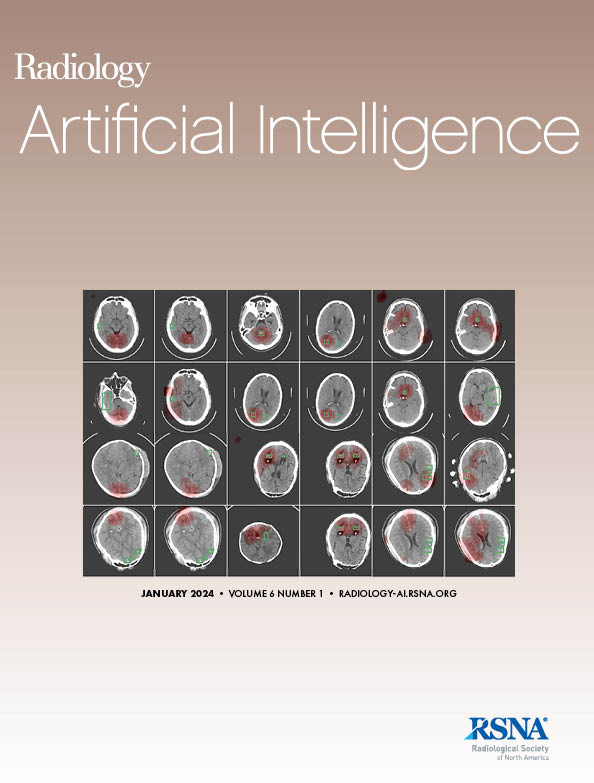Tina Dorosti, Manuel Schultheiß, Philipp Schmette, Jule Heuchert, Johannes Thalhammer, Florian T Gassert, Thorsten Sellerer, Rafael Schick, Kirsten Taphorn, Korbinian Mechlem, Lorenz Birnbacher, Florian Schaff, Franz Pfeiffer, Daniela Pfeiffer
求助PDF
{"title":"利用深度学习从胸片像素级厚度图估计总肺容量。","authors":"Tina Dorosti, Manuel Schultheiß, Philipp Schmette, Jule Heuchert, Johannes Thalhammer, Florian T Gassert, Thorsten Sellerer, Rafael Schick, Kirsten Taphorn, Korbinian Mechlem, Lorenz Birnbacher, Florian Schaff, Franz Pfeiffer, Daniela Pfeiffer","doi":"10.1148/ryai.240484","DOIUrl":null,"url":null,"abstract":"<p><p>Purpose To estimate the total lung volume (TLV) from real and synthetic frontal chest radiographs on a pixel level using lung thickness maps generated by a U-Net deep learning model. Materials and Methods This retrospective study included 5959 chest CT scans from two public datasets, the Lung Nodule Analysis 2016 (Luna16) (<i>n</i> = 656) and the Radiological Society of North America Pulmonary Embolism Detection Challenge 2020 (<i>n</i> = 5303). Additionally, 72 participants were selected from the Klinikum Rechts der Isar dataset (October 2018 through December 2019), each with a corresponding chest radiograph obtained within 7 days. Synthetic radiographs and lung thickness maps were generated using forward projection of CT scans and their lung segmentations. A U-Net model was trained on synthetic radiographs to predict lung thickness maps and estimate TLV. Model performance was assessed using mean squared error (MSE), Pearson correlation coefficient, and two-sided Student <i>t</i> distribution. Results The study included 72 participants (45 male and 27 female participants; 33 healthy participants: mean age, 62 years [range, 34-80 years]; 39 with chronic obstructive pulmonary disease: mean age, 69 years [range, 47-91 years]). TLV predictions showed low error rates (MSE<sub>Public-Synthetic</sub>, 0.16 L<sup>2</sup>; MSE<sub>KRI-Synthetic</sub>, 0.20 L<sup>2</sup>; MSE<sub>KRI-Real</sub>, 0.35 L<sup>2</sup>) and strong correlations with CT-derived reference standard TLV (<i>n</i><sub>Public-Synthetic</sub>, 1191; <i>r</i> = 0.99; <i>P</i> < .001) (<i>n</i><sub>KRI-Synthetic</sub>, 72; <i>r</i> = 0.97; <i>P</i> < .001) (<i>n</i><sub>KRI-Real</sub>, 72; <i>r</i> = 0.91; <i>P</i> < .001). When evaluated on different datasets, the U-Net model achieved the highest performance for TLV estimation on the Luna16 test dataset, with the lowest MSE (0.09 L<sup>2</sup>) and strongest correlation (<i>r</i> = 0.99; <i>P</i> < .001) compared with CT-derived TLV. Conclusion The U-Net-generated pixel-level lung thickness maps successfully estimated TLV for both synthetic and real radiographs. <b>Keywords:</b> Frontal Chest Radiographs, Lung Thickness Map, Pixel-Level, Total Lung Volume, U-Net <i>Supplemental material is available for this article.</i> © RSNA, 2025.</p>","PeriodicalId":29787,"journal":{"name":"Radiology-Artificial Intelligence","volume":" ","pages":"e240484"},"PeriodicalIF":13.2000,"publicationDate":"2025-07-01","publicationTypes":"Journal Article","fieldsOfStudy":null,"isOpenAccess":false,"openAccessPdf":"","citationCount":"0","resultStr":"{\"title\":\"Estimating Total Lung Volume from Pixel-Level Thickness Maps of Chest Radiographs Using Deep Learning.\",\"authors\":\"Tina Dorosti, Manuel Schultheiß, Philipp Schmette, Jule Heuchert, Johannes Thalhammer, Florian T Gassert, Thorsten Sellerer, Rafael Schick, Kirsten Taphorn, Korbinian Mechlem, Lorenz Birnbacher, Florian Schaff, Franz Pfeiffer, Daniela Pfeiffer\",\"doi\":\"10.1148/ryai.240484\",\"DOIUrl\":null,\"url\":null,\"abstract\":\"<p><p>Purpose To estimate the total lung volume (TLV) from real and synthetic frontal chest radiographs on a pixel level using lung thickness maps generated by a U-Net deep learning model. Materials and Methods This retrospective study included 5959 chest CT scans from two public datasets, the Lung Nodule Analysis 2016 (Luna16) (<i>n</i> = 656) and the Radiological Society of North America Pulmonary Embolism Detection Challenge 2020 (<i>n</i> = 5303). Additionally, 72 participants were selected from the Klinikum Rechts der Isar dataset (October 2018 through December 2019), each with a corresponding chest radiograph obtained within 7 days. Synthetic radiographs and lung thickness maps were generated using forward projection of CT scans and their lung segmentations. A U-Net model was trained on synthetic radiographs to predict lung thickness maps and estimate TLV. Model performance was assessed using mean squared error (MSE), Pearson correlation coefficient, and two-sided Student <i>t</i> distribution. Results The study included 72 participants (45 male and 27 female participants; 33 healthy participants: mean age, 62 years [range, 34-80 years]; 39 with chronic obstructive pulmonary disease: mean age, 69 years [range, 47-91 years]). TLV predictions showed low error rates (MSE<sub>Public-Synthetic</sub>, 0.16 L<sup>2</sup>; MSE<sub>KRI-Synthetic</sub>, 0.20 L<sup>2</sup>; MSE<sub>KRI-Real</sub>, 0.35 L<sup>2</sup>) and strong correlations with CT-derived reference standard TLV (<i>n</i><sub>Public-Synthetic</sub>, 1191; <i>r</i> = 0.99; <i>P</i> < .001) (<i>n</i><sub>KRI-Synthetic</sub>, 72; <i>r</i> = 0.97; <i>P</i> < .001) (<i>n</i><sub>KRI-Real</sub>, 72; <i>r</i> = 0.91; <i>P</i> < .001). When evaluated on different datasets, the U-Net model achieved the highest performance for TLV estimation on the Luna16 test dataset, with the lowest MSE (0.09 L<sup>2</sup>) and strongest correlation (<i>r</i> = 0.99; <i>P</i> < .001) compared with CT-derived TLV. Conclusion The U-Net-generated pixel-level lung thickness maps successfully estimated TLV for both synthetic and real radiographs. <b>Keywords:</b> Frontal Chest Radiographs, Lung Thickness Map, Pixel-Level, Total Lung Volume, U-Net <i>Supplemental material is available for this article.</i> © RSNA, 2025.</p>\",\"PeriodicalId\":29787,\"journal\":{\"name\":\"Radiology-Artificial Intelligence\",\"volume\":\" \",\"pages\":\"e240484\"},\"PeriodicalIF\":13.2000,\"publicationDate\":\"2025-07-01\",\"publicationTypes\":\"Journal Article\",\"fieldsOfStudy\":null,\"isOpenAccess\":false,\"openAccessPdf\":\"\",\"citationCount\":\"0\",\"resultStr\":null,\"platform\":\"Semanticscholar\",\"paperid\":null,\"PeriodicalName\":\"Radiology-Artificial Intelligence\",\"FirstCategoryId\":\"1085\",\"ListUrlMain\":\"https://doi.org/10.1148/ryai.240484\",\"RegionNum\":0,\"RegionCategory\":null,\"ArticlePicture\":[],\"TitleCN\":null,\"AbstractTextCN\":null,\"PMCID\":null,\"EPubDate\":\"\",\"PubModel\":\"\",\"JCR\":\"Q1\",\"JCRName\":\"COMPUTER SCIENCE, ARTIFICIAL INTELLIGENCE\",\"Score\":null,\"Total\":0}","platform":"Semanticscholar","paperid":null,"PeriodicalName":"Radiology-Artificial Intelligence","FirstCategoryId":"1085","ListUrlMain":"https://doi.org/10.1148/ryai.240484","RegionNum":0,"RegionCategory":null,"ArticlePicture":[],"TitleCN":null,"AbstractTextCN":null,"PMCID":null,"EPubDate":"","PubModel":"","JCR":"Q1","JCRName":"COMPUTER SCIENCE, ARTIFICIAL INTELLIGENCE","Score":null,"Total":0}
引用次数: 0
引用
批量引用

 求助内容:
求助内容: 应助结果提醒方式:
应助结果提醒方式:


